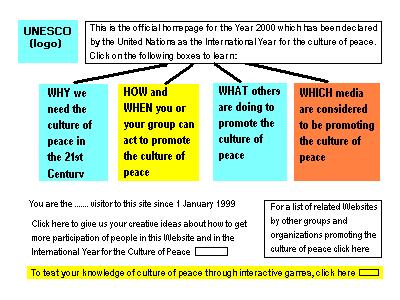Introduction and UNESCO's Mandate
Page 1
Yamousoukro and Seville Statement
Page 2
Origins and Executive Board Adoption
Pages 3 - 4
Launching the Programme: El Salvador and Roundtable
Pages 5 - 6 - 7
1993 General Conference
Page 8
National Projects
Pages 9 - 10
Programme Unit
Page 11
Toward a Global Scope
Pages 12 - 13
Transdisciplinary Project and Human Right to Peace
Pages 14 - 15 - 16
1997: A New Approach
Page 17
UN General Assembly Resolutions
Page 18
Resolution for International Year
Page 19
Declaration and Programme of Action
Pages 20 - 21
Resolution for International Decade
Pages 22 - 23
Training Programmes
Page 24
Global Movement
Pages 25 - 26
Publicity Campaign
Pages 27 - 28
Decentralized Network
Pages 29 - 30
Manifesto 2000
Page 31
Use of Internet
Pages 32 - 33
Future of the Culture of Peace
Pages 34 - 35 - 36 - 37 - 38
Early on, we recognized that Internet could play an important in the development of a global movement. This was foreseen in paragraph 92 of the document A/53/370 provided to the United Nations on 2 September 1998 as the basis for the Declaration and Programme of Action on a Culture of Peace:
[The mass media's] technological advances and pervasive growth have made it possible for every person to take part in the making of history, enabling for the first time a truly global movement for a culture of peace.
Over the Christmas holidays in 1997/1998, I worked out a draft set of Internet Web pages for the Global Culture of Peace Info-Net. This included pages whereby the Internet visitor could describe a newsworthy event or write a review of a film, TV program, video game or book, along with a rating system indicating how it contributes to the culture of peace. Soon it was renamed, the Culture of Peace News Network. (CPNN).

(click on design for enlargement)
In 1998 I devoted myself to the development of CPNN with Jan Visser who had come from Mozambique to develop Learning Without Frontiers, a UNESCO programme which also leaned heavily on the new Internet technology for its contribution to distance learning. In particular, we worked on the development of an approach that would make CPNN a "moderated" system, interposing trained moderators who would work with the visitors ("reporters") to put their reports into a form that could be put on-line on the Internet. Zeynep Varoglu, a young professional, joined the team and worked with a visiting psychologist from the United States, Katherine Stoessel, to develop a training procedure for moderators. Then, in 1999 we were joined by Di Bretherton, who accepted a contract to come work with us in Paris on sabbatical from Melbourne University in Australia, where she had established the International Conflict Resolution Center.
Using funds from the British money mentioned earlier, and some funds from the regular budget for the International Year for the Culture of Peace, as well as the participation of interns from a project funded by the Canadian government, we worked on the development of CPNN partner sites. Moderator-training was undertaken in Moscow, the Balkans, China, Jordan, Spain, Argentina, Chile, France, United States (with AARP) and Japan as well as with the World Scout Movement and with the International School of Paris. These were described briefly in the CPNN newsletter edited by Zeynep Varoglu in 2000.

Unfortunately, the network did not develop as quickly as we had hoped. Fund raising efforts, including a proposal for Microsoft via AARP, were unsuccessful. The partners were separated by language and geography without connecting links. Most of the sites were not kept up-dated and some partners began to drop out altogether. The upgrading of the Australian site, originally expected by mid-2000, was delayed by a year. Over the Christmas holiday 2000/2001, I drafted a new proposal that would further develop the Australia site as a central site, linking up all the others in a multi-lingual network. This proposal was presented at that time to Di Bretherton, who came from Australia, and to Takehiko Ito, who came from Japan and a UNESCO contract was issued for its development during 2001.
 |
 |
 |